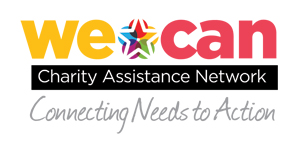The motivation for WE CAN was born in a very specific moment on a rainy fall Tuesday in Washington D.C. I walked in to Miriam’s Kitchen, a soup kitchen/homeless shelter; the volunteer coordinator gave a great overview of what Miriam’s kitchen does every day for their clients. Each client was handed a card and circled any of the clothing options they needed. My job would be to take the card, walk down the stairs, get the clothes the client is in need of, and deliver it to them with a smile on your face.
It was amazing to see the joy on the client’s faces as I would emerge from the staircase with a coat or a new pair of shoes. I repeated this task over and over, running up and down the stairs. Everything seemed to be going fine until I noticed we were running low on clothing items.
I was beginning to have to only give clients partial orders, what once was a look of joy was now a look of disappointment that the service organization didn’t have what they needed in their time of desperation.
I had five minutes left on my shift and there wasn’t anyone else left to serve, I figured my day was done, little did I know those five minutes would change my life forever.
A very large man walked up to me, he was soaking wet and shivering from the cold but still looked at me, smiled and handed me a card with a winter jacket circled on it — size small. My heart immediately sank to my stomach, I knew for a fact that we were out of jackets.
I faked a smile and turned towards the stairs again, I frantically sifted through empty drawers and boxes. I called over the volunteer coordinator and asked where they kept the other jackets; she shrugged her shoulders and informed me that individuals donated everything. Once they run out, there’s nothing you can do.
For the first time that day I walked up the stairs very slowly and empty handed, I explained that I was very sorry but we don’t have any jackets left. The man looked back and snapped at me, his calm voice now filled with rage “you didn’t look hard enough! Go back there and check again!” I was shocked; I apologized again and assured him I had checked thoroughly.
The man stopped himself and reached out to shake my hand, he told me he was very sorry. Assured me it was not my fault, he was now back to his calm quiet tone when he said “I do appreciate you for what you’re doing here, I really do man. It’s just tough because this jacket isn’t for me. No sir, this jacket is for my son over there.” He pointed across the room to his 9-year-old son. He explained that they had been homeless together for the past 4 months and it’s always hard, but it’s a lot harder when it rains.
With that he shook my hand again and told me that he truly wanted to thank for me everything I had done for him. I couldn’t believe that the biggest thank you I got was from the one person I couldn’t do anything for. I witnessed as he took his son’s hand and the two of them walked into the pouring rain on that Tuesday in October. I couldn’t stop replaying that moment.
I spoke with the volunteer coordinator and asked her a simple question. “What are your top three most urgent needs?” She rattled off three specific clothing items that they always needed, number one was a winter coat. She said that they were always getting useless donations and things they couldn’t use even if they tried.
I always assumed that donating anything to a charity was the best thing I could do. I didn’t ever think about asking a charity what it needs from me specifically. I realized right then as I walked home under my warm coat that I wanted to create a way to communicate between charities and volunteers.
I hadn’t even had the idea for more than 24 hours before it already began to change. The next day we were working for an organization called A Wider Circle, they focus on professional clothing. It allows people in poverty to interview for jobs with a newfound confidence when they are wearing a tailored suit. I struck up a conversation with the volunteer coordinator, I told him about the experience I had the day before with the coat. When I asked him if they had a similar problem he looked at me and laughed. He showed me the basement filled with donated goods. I was in shock when I lost count of the rows of winter jackets, how could this all be sitting here I thought, so many people could have used this yesterday. I turned back to him in a moment of sheer bewilderment and asked him if he had ever heard of Miriam’s kitchen? He furrowed his brow and shook his head no.
It just seemed so strange to me that if two organizations had the same social cause of ending poverty and relieving homelessness why wouldn’t they work together? How is it that charities don’t communicate with other charities to work together? This lack of connectedness is an area I plan on helping to change.
My preliminary research has been my own personal experiences, whether it was studying food insecurity in St. Louis or rebuilding homes in New Orleans; the problem seems to exist everywhere I have served. I am eager to go about solving the problems through the development and implementation of We Can – Charity Assistance Network.
